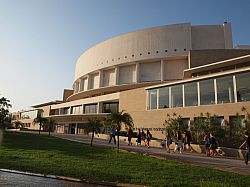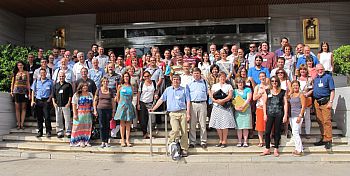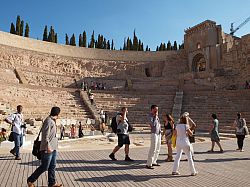LASI researcher Norman Carreck recently attended these two meetings in Murcia, Spain. The 10th Meeting of COLOSS represented its first year as a non-profit association, and was attended by about 90 delegates (Fig. 1). Updates were given on continuing projects. The continuing winter loss surveys project has recently published a major paper analysing colony loss data from 19 counties, with several new countries now joining the project. The Research
 The Centro de Congresos Victor Villegas, Murcia, Venue for EurBee6. Photo: Norman Carreck.
The Centro de Congresos Victor Villegas, Murcia, Venue for EurBee6. Photo: Norman Carreck.
Network on Sustainable Bee Breeding recently published the results of the ambitious Genotype-Environment-Interactions Experiment which compared sixteen trains of bee in sixteen different locations around Europe and found that local strains of bee consistently survived better than strains from elsewhere. A bee wing reference database is being set up. The Varroa Control Task Force has a number of joint experiments on integrated control in progress in various countries.
A new Core Project entitled B-RAP (Bridging Research and Practice) has been set up to focus on extension activities for beekeepers and beekeeping, to ensure that learning and understanding generated from research projects reaches the beekeepers and leads to modified practice. The new APITOX project was formally instituted to investigate the effects of environmental toxicants and routes of exposure of chemicals on bees. The aims of COLOSS APITOX are to: evaluate existing risk assessment protocols; identify necessary improvements to EFSA guidelines; identify the most important EFSA guideline tests that need to be validated; organize international working groups for developing and ring-testing new OECD Test Guidelines; and promote existing risk assessment protocols that are effective in protecting bees and bee colonies. The CSI Pollen project had a successful first year, with about 400 “Citizen Scientist” beekeepers in 21 countries with more than 1,000 colonies collecting pollen samples every three weeks. This will help to build up information about regional differences in pollen diversity and hence the diversity of food available for bees. Six new countries are to join the project in 2015.
COLOSS was immediately followed by the sixth European Conference of Apidology (EurBee) which was attended by 329 delegates from 43 countries (Photo 2). Over three days, five plenary and 127 submitted talks, together with 155 posters were presented. Sessions covered: advancing bee health; population
 Members of the COLOSS association. Photo: Karl Crailsheim
Members of the COLOSS association. Photo: Karl Crailsheim
genetics and conservation; effects of stressors on the behaviour of bee pollinators; physiology; bee products; advances in the chemical ecology of bees;
 Delegates to EurBee6 visit the Roman theatre at Cartagena. Photo: Norman Carreck.
Delegates to EurBee6 visit the Roman theatre at Cartagena. Photo: Norman Carreck.
genomics; and the neural basis of behaviour in the honey bee. The plenary talks were wide ranging: Prof. Dave Goulson (University of Sussex, UK) on the impacts of pesticides and other stressors on bee health; Dr Dennis van Englesdorp (USA) on factors affecting colony health in the US; Prof. Ingolf Steffan-Dewinter (Germany) on the impacts of land use changes on bee diversity and crop pollination services; Dr Vera Imperatrix-Fonseca (Brazil) on pollination services of neotropical bees; and Dr Peter Rosenkranz (Germany) on parasite-host interactions during the reproductive cycle of varroa.
Norman Carreck gave a talk about neonicotinoids and bee foraging on sweetcorn in West Sussex which is currently being written up for publication. This complemented the talk by University of Sussex colleague Dr Christina Botías on neonicotinoids in oilseed rape crops and surrounding vegetation on local farms.


